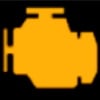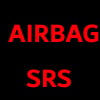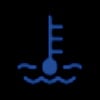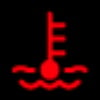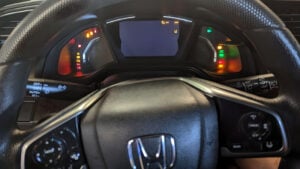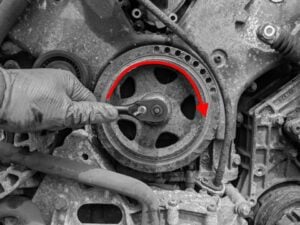Porsche Dashboard Warning Lights and Symbols
Is there a warning light displayed on your Porsche dashboard? Learn the warning light’s meaning and possible solutions to fix the problem by checking the list below.
This guide will explain Porsche Dashboard Warning Lights and Symbols.
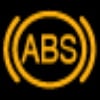
Anti-Lock Brake System Fault Indicator The system malfunctions if the ABS warning light is illuminated while the engine is running. If ABS is not working properly, the brake system then operates without using ABS. The ABS prevents the brakes from locking up during hard braking. Take caution not to brake too hard while the ABS is malfunctioning. Use an ABS scanner to diagnose problems with the system. Common ABS faults:
|
|
Check Engine Light / Service Engine Soon The service engine soon lamp means a fault has occurred in one of the various vehicle systems. It will only turn on when a vehicle recognizes a significant enough problem that needs to be serviced. A code will be stored within the vehicle’s computer to give more detail on the problem at hand. Follow this guide to scan the vehicle’s computer for trouble codes to see why the check engine light has turned on. If the light is steady, it is normally okay to drive for the time being. Do NOT drive the vehicle if the check engine malfunction indicator light (MIL) is blinking. This is usually a sign of misfire and, oftentimes, catalytic converter failure, which can lead to massive engine failure if driven. Common causes of the service engine soon indicator:
|
|
Air Bag Warning Light When the vehicle is first turned on, this warning light will illuminate for approximately seven seconds. If the light stays on while the engine runs, the vehicle’s safety restraint system needs to be serviced. Proceed with caution when diagnosing this yourself, as airbags can involuntarily deploy/discharge, causing injury or even death. Use an Airbag OBD-II Scanner to read the diagnostic trouble codes. It is important to have the airbags working properly in case of an accident. |
|
Engine Temperature Indicator The blue engine temperature light means the vehicle is not up to temperature; the vehicle will warm up with engine idling or while driving. It will go off after the vehicle has reached normal operating temps. The red engine temperature warning light means the vehicle coolant temperature is overheating. Check the temperature gauge to see if the vehicle is running hot. Pull the vehicle over and refer to the owner’s manual or a guide on safely checking the vehicle’s coolant level once the engine cools down. Service the cooling system for potential leaks or problems. Common causes of the engine temperature indicator light:
|
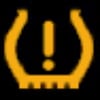
Tire Pressure Monitor Indicator The tire pressure monitor indicator means low tire pressure in your vehicle’s tires. Check the vehicle’s information display for which position the tire is in that is low. Fill the tire to correct air pressure and drive a few miles; the light will turn off on its own. If the light stays on, it may be caused by a faulty TPMS sensor in one of the tires. To service the TPMS system, a TPMS relearn tool will be needed. Common TPMS faults:
|
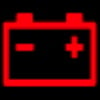
Charge System Trouble Indicator If the battery warning light comes on while the engine is running, it indicates the charging system is not functioning properly. Turn off the engine and check the generator (alternator) belt is in working condition. Do not continue driving if the belt is loose, broken, or missing. Test the charging system with a battery load and cranking system tester. Common causes of the charging system light:
|
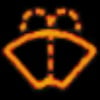
Low Washer Fluid Indicator This light means that the fluid in the windshield washer reservoir is low. Refer to the owner’s manual for the location of the reservoir. Alternatively, you can look under the hood for a blue cap with the same symbol. Check its level and fill it appropriately. |
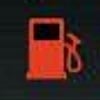
Low Fuel Indicator This light means the vehicle is close to having an empty fuel tank. Some vehicles will display the approximate amount of miles the vehicle can still be driven before it will completely runs out of fuel. It is always wise to fill up on gas without running it too low, as this causes the fuel pump to work even harder when it’s low and can lead to premature failure. |

Oil Warning Light This light warns of low engine oil pressure. It is an indicator of insufficient oil pressure through the oil passages and the engine’s main bearings. It is possible the engine oil level is low. Pull the vehicle over, shut off the engine, and check the engine oil. If the level is low, fill to a normal level and drive the vehicle to see if the light goes off. If the light stays on, have the vehicle towed to a shop; driving with low oil pressure can lead to immediate and serious damage to the engine. Common causes of the oil warning light:
|
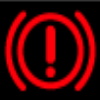
Brake Light The brake light on means the brake system needs to be serviced. We do not recommend driving the vehicle with the brake light on. Use your best judgment to determine if the vehicle is safe to drive. Check the brake fluid level. If in need of repairs, have the vehicle towed to the shop; driving in this condition could be dangerous. Common causes of the brake indicator light:
|

Economy Mode Operation Indicator The vehicle will adjust engine and transmission performance in economy mode for the best fuel economy. For example, engine RPMs don’t reach high values, and transmission may shift earlier. These adjustments help keep fuel consumption down. |

High Beam Indicator This light means the high beams are turned on. You should only use this setting if you are the only vehicle on the road. Do not keep the high beams on if you are coming in the opposite direction or other vehicles in front of your vehicle. Pull the turn switch towards the back of the vehicle to turn off the high beam. |

Lane Keeping Indicator This light means that lane assist is enabled. If you leave the lane without turning on the blinker, this light should flash. The steering will be adjusted to keep the vehicle in the center of the driving lane. If the steering is turned by the driver, it will cancel the adjustment, and the driver will regain control. |
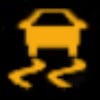
Stability Control Indicator This light means that the stability control has been disabled. The vehicle can be driven but keep in mind stability control is off. In most cases, this light comes on at the same time that the ABS light comes on. If that is the case, there is a high chance one of the wheel speed sensors is faulty. Use an ABS Scanner to read the fault codes from the ABS and traction control modules. |
|
Electronic Power Steering Trouble This light means there is a problem with the electronic power steering. The steering wheel will require a greater steering effort to turn. Take caution while driving; the power steering will need to be serviced. If the vehicle is not safe to drive, have it towed to a shop. |

Turn Signal Indicator The turn signal indicator turns on and flashes when the turn signal switch indicates the driver turning left or right. Push the turn signal stalk up or down to turn on the turn signal indicator. If the lamp flashes rapidly, it signifies a bad bulb. Common turn signal indicator issues:
|
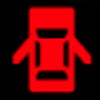
Door Ajar The door ajar indicator stays illuminated when any of the doors or trunks are not closed properly. If this indicator does not go off even after closing the door properly, it may be caused by worn-out latches in the door or a faulty door-ajar sensor. Common causes of the door ajar indicator light on a Nissan vehicle:
|
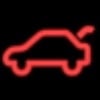
Boot Open The boot open indicator means that the vehicle’s boot is open. Make sure it is closed properly, and the lamp will turn off. If the lamp stays on, there may be a problem with the open sensor. The latches that keep it close could also be loose or need to be adjusted. |
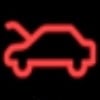
Bonnet Open The bonnet open indicator means that the bonnet of the vehicle is open. Make sure it is closed properly, and the lamp will turn off. If the lamp stays on, there may be a problem with the open sensor. The latches that keep it close could also be loose or need to be adjusted. |

Park Lamps ON Indicator This lamp means the parking lights have been turned on. Typically the low beam switch controls the parking lights. Turn the switch one more click to turn on the low beams, or turn the opposite way to turn all lights off. |
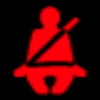
Seat Belt Reminder This is a reminder to fasten the front driver or passenger’s seatbelt. While the vehicle is in motion and the seatbelt is unfastened, an audible chime will repeat. Fasten any passengers’ seatbelts for the warning to go off. If a warning still happens, there is a malfunction. Common seat belt warning malfunctions:
|

Fog Lamp Indicator This light means the front fog lights are turned on. To turn off the fog lights and indicator, push the headlight dial. |

Message Indicator The message indicator means there is a common fault happening. Check the dash for a message detailing the problem. This message will appear on the information display whenever the ignition is turned on. Fix the problem causing the error for the message indicator to go off. Common causes of the message indicator:
|
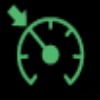
Cruise Control Indicator This light means that cruise control has been enabled. The vehicle will keep a constant speed. Cruise control will turn off if you press the brakes. Note that, in this case, there is no adaptive cruise control. The vehicle will not keep a safe distance from the vehicle in front. |

Catalytic Converter Error This light means the catalytic converter is either overheating or not operating as intended. This is usually due to a clogged or failing catalytic converter. The converter will likely have to be replaced at an exhaust shop or dealer. Driving with a clogged converter can lead to engine failure; do not drive if the engine is misfiring or feels different. |
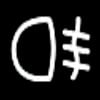
Back Fog Lights The fog lamp indicator pointing to the right means the rear fog lights are on. The fog lamps can be turned off at the headlight switch. Depending on the model, turn the stalk or push the dial to turn the fog lights off. |
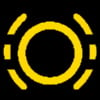
Brake Pads Warning This light means the brake pads are worn out and too thin. A thin brake pad can warp the rotors or seal the calipers. This is because when worn out, they are less efficient and get rid of the heat caused by the braking friction. Have the brakes serviced immediately when this light is on. |
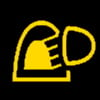
Rain Sensor This light means the rain sensor is turned on. This can be turned on or off at the windshield wiper stalk. If rain sense is active, the wiper blades will automatically start wiping when rain is detected on the windshield. |

Winter Mode for Gearbox Winter mode is a drive mode intended for slippery starts. It is not for extreme conditions when the vehicle is in motion. Winter mode starts the vehicle in second or third gear to put less torque to the wheels to provide the most traction and the least amount of wheel slip. This can work for icy roads or loose ground like sand and gravel. |

Diesel Pre-Heat Indicator This light means the glow plugs are preheating the engine block. It helps warm up the engine block so the diesel fuel can combust on diesel engines. There is no spark in a diesel engine, and combustion is done by compressing the fuel to detonation. The higher the temperature is, the easier it is to combust. |

Possible Frost This light means there is a frost condition on the road. It turns on when the outside ambient temperature goes below a certain degree. If roads are icy, this can be a hazard to drive in. Always drive with caution when there are icy roads. |
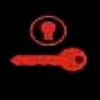
Ignition Switch Warning This light means there is a fault with the ignition system. Either the key is no longer correctly verified by the computer, or the ignition switch is faulty. The vehicle will likely not be able to start in this condition. Have the vehicle towed to a shop. A new ignition switch and the key will need to be programmed to the vehicle’s computer with a professional OBDII scan tool. |
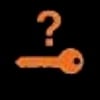
Key Not Found in Vehicle The key not found light comes on when the key is not in the vehicle or the key battery has died. If the key battery has been replaced and is near the vehicle, the key is likely faulty. A new key must be programmed with the vehicle for it to work. |
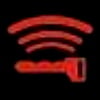
Key Battery Low This light means the key battery is low. It is recommended that the key battery be changed as soon as possible. If the key battery runs out, it is possible the vehicle won’t be able to be started, and this could leave the driver stranded. |

Distance Too Low to Vehicle in Front This light means the following distance from the vehicle ahead is too close. The vehicle settings can set a set interval. This interval is used to aid the driver in mitigating collisions. It alerts the driver so they can take action and avoid a crash. Radar and cameras in the front of the vehicle sense the other vehicles. |

Press Clutch Pedal This light is a reminder the clutch needs to be pressed before the engine can start. Press the clutch in and start the engine for this light to go off. This light is only on manual transmission vehicles. |
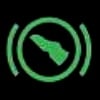
Press Brake Pedal This light is a reminder to press the brake while starting the vehicle. Press the brake and start the vehicle, and the light will go off. This light is only on automatic transmission vehicles. |
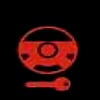
Steering Locked This light means the steering is locked and can not be turned without turning the ignition to the ON position. Turn the ignition on, and the light will go away. |

Sidelights On This light means the side marker lights are turned on. The headlight switch can turn these off. If you turn them off, the indicator lamp will also turn off. |
 
Exterior Lights Warning This light means there is a fault with one of the vehicle’s exterior lights. One of the bulbs in the lights, such as taillights, headlights, parking lights, sidelights, license plate lights, and more, could be bad. Replace the bad bulb so this warning goes off. It is also common for the wiring to develop an open since lights take a lot of power, and resistance builds up in old wires. |
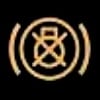
Brake Light Warning This light means the brake light bulb is bad in the taillights. Step on the brakes to see if the lights are coming on. Replace the bad bulb, and the warning lamp will go away. |
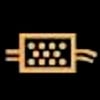
Diesel Particulate Filter Warning This light means that the diesel exhaust fluid (DEF) level is low or that there is a problem with the diesel particulate filter (DPF). If the DEF is left unfilled, the vehicle will go into limp mode, reducing its speed to five miles per hour to prevent harmful emissions or damage to the DEF system. This light may also come on due to contaminated fluid. It is always important to remain vigilant and check that the DEF is always clean and at an acceptable level when performing routine maintenance. Common causes of the diesel exhaust fluid warning indicator:
|
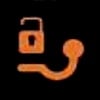
Tow Hitch Error This light means the electronic tow hitch is malfunctioning. An error message will display on the dash. Use an OBDII scan tool to get more information on the fault. The tow hitch may malfunction due to a bad electric motor, the trailer module, or wiring. |
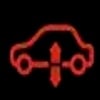
Air Suspension Error This light means the air ride suspension has a fault and will not work as intended. Have the vehicle serviced and use a Porsche Durametric OBD-II scanner to read the body module. Common faults include a bad control unit, compressor, and wiring. |

Parking Brake Light This light indicates the parking brake is on. Can illuminate either red or yellow in color. If the parking brake is off, this light indicates the parking brake system needs to be serviced. Common causes of the electronic park brake indicator light on a Nissan vehicle:
|
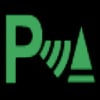
Parking Sensors On This light means the parking sensors are active. The parking sensors will aid in parking and detect vehicles near via radar sensors. If a vehicle is too close, an audible warning will beep to alert the driver to apply the brakes to avoid a collision. |
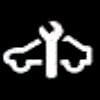
Service Needed This light means a maintenance service is needed. It comes on at the intervals set in the owner’s manual. Oil changes, tire rotations, transmission flushes, coolant flushes, and more may need to be serviced. The light can be turned off by a sequence or in the settings. |
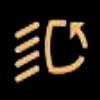
Adaptive Lights ON This light means the adaptive headlights are on. The adaptive headlights keep the headlights on the road when cornering by adjusting them. They use steering inputs to know where to adjust the headlights too. |
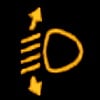
Headlights Height Adjustment This light means the headlights can not adjust to where they need to. The adjustments have maxed out, or the headlight height adjustment is malfunctioning. If the vehicle ride height has been adjusted, it may throw off the sensors used to adjust the headlights, or the vehicle may be sitting too low. |
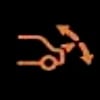
Rear Spoiler Warning This light means the rear spoiler is in motion. This happens when the spoiler is put up or put away. If this light stays on after the spoiler has mounted, then there is a malfunction. Check the spoiler is working properly. |
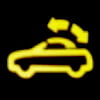
Roof Error This indicator only shows when the convertible roof is functioning (being opened or closed). It does not stay on if the convertible roof is in its fully opened or closed position. If it is stuck and not operating properly, this light will stay on. |
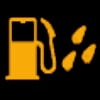
Water in the Fuel Filter Detected The water in the fuel indicator detects any water within the diesel fuel tank by the fuel filter. This needs to be serviced. Excess water can be drained, the fuel filter replaced, or the entire system drained and replaced. |

Airbag Turned Off This light means that airbags we deactivated. The airbags will be turned off automatically in the passenger seat if no one is detected sitting there. The airbags may also have been turned off manually. If the airbag off light remains on in the event they are turned back on, the airbag system is malfunctioning. Have the airbag system service. |

Mechanical/Electrical Error This light means a mechanical or electrical error has been detected within the vehicle. Check the display for more information and a message with this error. |
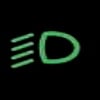
Dipped Beam Headlights This light means the low-dipped beam headlights are active. The headlight stalk/switch allows you to switch them on or off. If you turn them off, the indicator will disappear. |
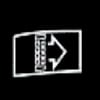
Air Filter Needs Replacement This light means the service interval at which the air filter needed to be replaced has occurred. This interval is set by miles and will occur when the set mileage has happened on the odometer. Replace the air filter and reset the light. Refer to the owner’s manual for the sequence to reset the light. |
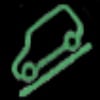
Hill Descent Control Indicator The hill descent control indicator means that the brake and throttle are being adjusted to prevent tumbling down or slipping on steep terrain. It also avoids getting stuck or slipping on slippery or difficult terrain. This light will be on when this mode is active. This mode can be turned off completely by pushing the button on the dash, and the light will also turn off. |

Fuel Filter Error Detected The fuel filter error detects any water within the diesel fuel tank by the fuel filter. This needs to be serviced. Excess water can be drained, the fuel filter replaced, or the entire system drained and replaced. |
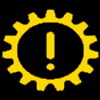
Automatic Gearbox Error The automatic transmission fault indicator has a problem with the automatic transmission. This light will show on the information display and will include a message. Check the message for more information on this fault. An OBDII scan tool will be needed to read the ECU for automatic transmission trouble codes. Diagnose and repair the transmission to get rid of the transmission fault indicator. |

Speed Limiter Activated This light means a speed limit has been set, and the vehicle will not be allowed to drive above it. When the vehicle reaches the set speed, acceleration will automatically stop even if the throttle is pressed. |
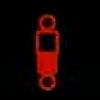
Chassis System Warning This light means the air ride suspension has a fault and will not work as intended. Have the vehicle serviced and use a Porsche Durametric OBD-II scanner to read the body module. Common faults include a bad control unit, compressor, and wiring. |

Windscreen Defrost Activated This light means the front windscreen defrost is on. The dash button can activate or deactivate it. |
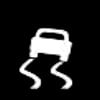
Electronic Stability Control OFF This indicator comes when the Electronic Stability Control (ESC) is off. It is either off due to malfunction or was manually turned off. ESC is recommended to keep the vehicle from slipping and losing control in hazardous situations. It can usually be turned on and off with the button on the dash. If the light stays on constantly and traction control can not be turned on, the system has been turned off due to malfunction or an ABS problem. |
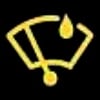
Rain Sensor Activated This light illuminates when the rain sensor is on. With the rain sensor on, any time rainwater is detected on the windshield, the wiper blades will turn on automatically. To turn off the rain sensor, press the button on the windshield wiper stalk. The light will also turn off. |
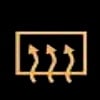
Rear Window Defrost ON This light means the rear windscreen defrost is on. The dash button can activate or deactivate it. |

Automatic Windscreen Wipers On This light means that the wipers can be turned on, and the speed will automatically be adjusted. It adjusts the speed by sensing how many water droplets are hitting the windscreen. This can be turned off on the windscreen wiper stalk. |

General Warning The general warning means there is a common fault happening. Check the dash for a message detailing the problem. This message will appear on the information display every time the ignition is turned on. Fix the problem causing the error for the attention indicator to go off. Common causes of the attention indicator:
|
Many of these lights on a Porsche are intended to inform the driver when a system is enabled.
A few of these lights indicate a problem or malfunction and inform the driver that that particular system has been disabled.
To find out what is wrong with these systems, use an All System Porsche Scanner to read the fault codes from the corresponding module. Note that generic OBD-II scanners can only read check engine codes and cannot diagnose other systems such as airbags, ABS, traction control, etc.
We hope you find the Porsche Dashboard Warning Lights and Symbols guide helpful. Check these troubleshooting and repair guides for more help on your Porsche.




